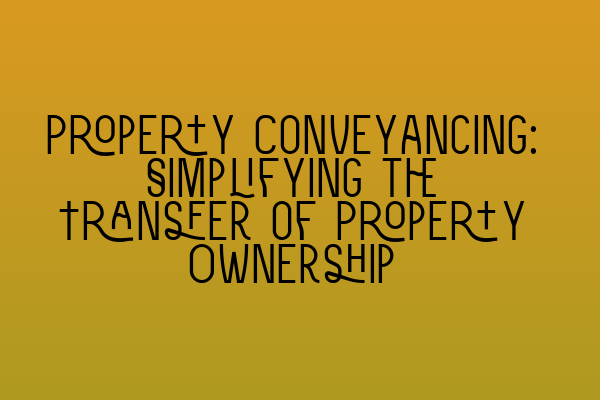Property Conveyancing: Simplifying the Transfer of Property Ownership
When it comes to buying or selling property, the process of transferring ownership can be quite complex. This is where property conveyancing comes into play. Property conveyancing refers to the legal process of transferring property ownership from one person to another. It involves various legal documents, searches, and inspections to ensure a smooth and lawful transfer of property.
At SQE Property Law & Land Law, we specialize in property conveyancing and aim to simplify this process for our clients. In this article, we will provide an overview of property conveyancing, its importance, and the steps involved. So, let’s dive in!
Why is Property Conveyancing Important?
Property conveyancing is a crucial aspect of any property transaction. Whether you are buying or selling property, it is essential to ensure that the transfer of ownership is done in a legal and proper manner. Here’s why property conveyancing matters:
- Legal Compliance: Property conveyancing ensures compliance with all relevant laws and regulations governing property transactions. This helps protect the rights and interests of all parties involved.
- Title Investigation: Conveyancing involves conducting thorough title searches to verify the ownership status of the property, identify any existing encumbrances (such as mortgages or liens), and ensure that the property is free from any legal issues.
- Contract Drafting and Review: A crucial part of property conveyancing is drafting and reviewing the contract of sale or purchase agreement. This ensures that all terms and conditions are fair, accurate, and legally binding.
- Financial Protection: Property conveyancing involves careful examination of financial aspects, such as ensuring that all necessary payments, taxes, and fees are settled correctly. This helps protect both the buyer and the seller from any financial risks.
The Steps Involved in Property Conveyancing
Property conveyancing can be divided into several key steps. Let’s take a closer look at each of these steps:
1. Instruction
The process begins with the instruction phase, where the buyer or seller engages a solicitor or conveyancer to handle the conveyancing process on their behalf. During this stage, the solicitor collects essential information regarding the property and the transaction.
2. Pre-contract Stage
Once instructed, the solicitor will carry out various pre-contract searches and checks. These may include local authority searches, environmental searches, drainage and water searches, and more. The purpose of these searches is to identify any potential issues that may affect the property.
3. Contract Preparation
Next, the solicitor drafts or reviews the contract of sale or purchase agreement, ensuring that it accurately reflects the terms and conditions agreed upon by both parties. The contract will include details such as the parties involved, the purchase price, and any special conditions or clauses.
4. Exchange of Contracts
Once both parties are satisfied with the contract, the solicitors will exchange contracts. This is a legally binding step where the buyer and seller commit to the transaction. At this stage, a deposit is usually paid by the buyer.
5. Completion
The completion stage is when the property transaction is finalized. The remaining balance is paid, and the property officially changes ownership. It is the responsibility of the solicitor to ensure that all necessary payments, including Stamp Duty Land Tax, are made in a timely and accurate manner.
6. Post-completion
After completion, the solicitor works on post-completion matters, such as registering the change of ownership with the Land Registry, transferring any mortgage deeds, and providing legal documentation to the buyer.
Final Words
Property conveyancing plays a crucial role in ensuring the smooth and lawful transfer of property ownership. It involves several intricate steps, including instruction, pre-contract searches, contract preparation, exchange of contracts, completion, and post-completion matters. At SQE Property Law & Land Law, we have extensive experience in property conveyancing, and our knowledgeable solicitors can guide you through the process with ease.
If you have any questions or require assistance with property conveyancing, please feel free to contact us. We are here to help.
Related Articles:
- Updates in UK Property Laws: Key Changes and Implications
- Legal challenges in property transactions: A comprehensive guide
- Navigating Lease Laws in the UK: Essential Guidelines for Tenants and Landlords
- Dominate Property Law Questions: Avoiding Common Pitfalls
- Land Law Revision Tips: Ace Your Exam Preparation
